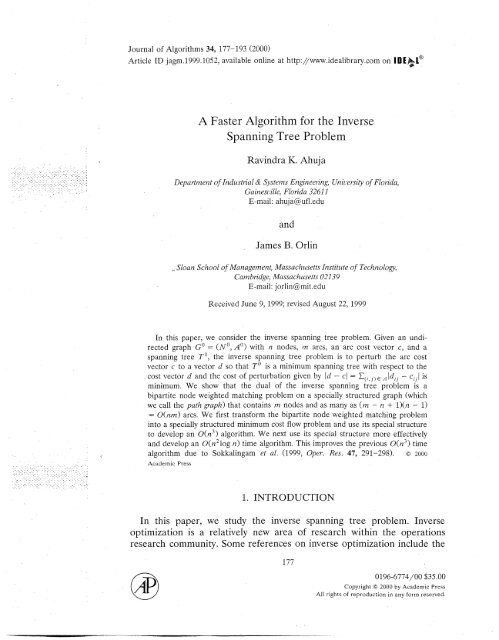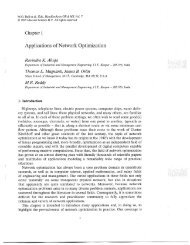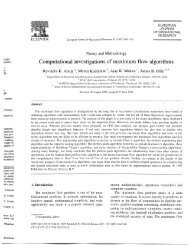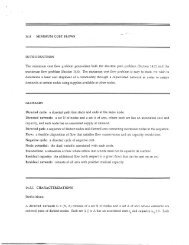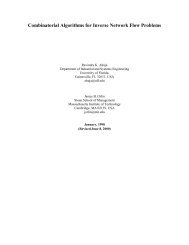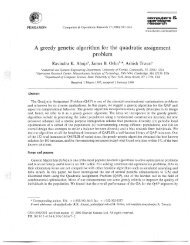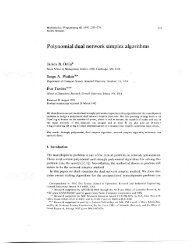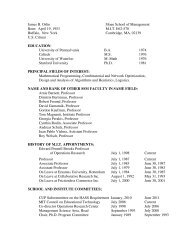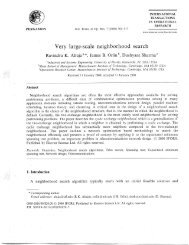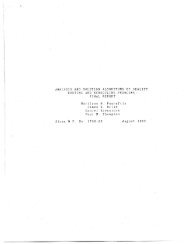A Faster Algorithm for the Inverse Spanning Tree Problem ,..... ,...,.... ..
A Faster Algorithm for the Inverse Spanning Tree Problem ,..... ,...,.... ..
A Faster Algorithm for the Inverse Spanning Tree Problem ,..... ,...,.... ..
Create successful ePaper yourself
Turn your PDF publications into a flip-book with our unique Google optimized e-Paper software.
Journal of <strong>Algorithm</strong>s 34, 177-193 (2000)<br />
Article ID jagm.1999.1052, available online at http://www.idealibrary.com on 10iDE al ®<br />
A <strong>Faster</strong> <strong>Algorithm</strong> <strong>for</strong> <strong>the</strong> <strong>Inverse</strong><br />
<strong>Spanning</strong> <strong>Tree</strong> <strong>Problem</strong><br />
AP-<br />
"':` . ''"`'''''<br />
"; .·.. · ...... ."""""'<br />
·,·.··.··..-.··..-<br />
..<br />
c `'"'' .-,·-..-<br />
Ravindra K. Ahuja<br />
Department of Industrial & Systems Engineering, University of Floida,<br />
Gainesville, Florida 32611<br />
E-mail: ahuja@ufl.edu<br />
and<br />
James B. Orlin<br />
,, Sloan School of Management, Massachusetts Institute of Technology,<br />
Cambridge, Massachusetts 02139<br />
E-mail: jorlin@mit.edu<br />
Received June 9, 1999; revised August 22, 1999<br />
,.....<br />
,...,....<br />
.. r.··n r. . .,..·..,<br />
In this paper, we consider <strong>the</strong> inverse spanning tree problem. Given an undirected<br />
graph G o = (Ni, AO) with n nodes, mn arcs, an arc cost vector c, and a<br />
spanning tree T, <strong>the</strong> inverse spanning tree problem is to perturb <strong>the</strong> arc cost<br />
vector c to a vector d so that T is a minimum spanning tree with respect to <strong>the</strong><br />
cost vector d and <strong>the</strong> cost of perturbation given by Id - c = L(l j) Aldij - ciil is<br />
minimum. We show that <strong>the</strong> dual of <strong>the</strong> inverse spanning tree problem is a<br />
bipartite node weighted matching problem on a specially structured graph (which<br />
we call <strong>the</strong> path graph) that contains m nodes and as many as (m - n + 1)(n - 1)<br />
= O(nm) arcs. We first trans<strong>for</strong>m <strong>the</strong> bipartite node weighted matching problem<br />
into a specially structured minimum cost flow problem and use its special structure<br />
to develop an O(n 3 ) algorithm. We next use its special structure more effectively<br />
and develop an O(n21log n) time algorithm. This improves <strong>the</strong> previous O(n 3 ) time<br />
algorithm due to Sokkalingam et a. (1999, Oper. Res. 47, 291-298). © 2000<br />
Academic Press<br />
1. INTRODUCTION<br />
In this paper, we study <strong>the</strong> inverse spanning tree problem. <strong>Inverse</strong><br />
optimization is a relatively new area of research within <strong>the</strong> operations<br />
research community. Some references on inverse optimization include <strong>the</strong><br />
177<br />
0196-6774/00 $35.00<br />
Copyright © 2000 by Academic Press<br />
All rights of reproduction in any <strong>for</strong>m reserved.<br />
'-^OwUlblllll ---1 lL--6·------ -- - = --- ·------------- --- ----------
178 AHUJA AND ORLIN<br />
.. l..t . I.. ,... ..,.......<br />
.·<br />
c ... ·.. . ··.....<br />
i<br />
*.. ·r<br />
rl ·r:...,.<br />
r·<br />
...:.....· r·<br />
I,<br />
following: Burton and Toint [5, 6], Burton et al. [4], Cai and Li [7], Cai,<br />
Yang, and Li [8]. Xu and Zhang [12], Yang and Zhang [13], Yang et al.<br />
[14]. Zhang and Cai [15], Zhang et al. [12, 18], and Ahuja and Orlin [2, 3].<br />
This paper improves upon <strong>the</strong> previous algorithm of Sokkalingam et al.<br />
[10] <strong>for</strong> <strong>the</strong> inverse spanning tree problem.<br />
We first give some network notation. Let G O = (N ° , A ° ) be a connected<br />
undirected network consisting of <strong>the</strong> node set N O and <strong>the</strong> arc set A °. Let<br />
c denote <strong>the</strong> arc cost vector. Let n = IN°1 and m = AO. We assume that<br />
N O = (1,2,..., n} and AO = {a,, a,..., an}. We denote by tail[j] and<br />
head[j] <strong>the</strong> two endpoints of <strong>the</strong> arc a. Since each arc a is undirected, we<br />
can make any of its endpoints as tail[j] and <strong>the</strong> o<strong>the</strong>r endpoint as head[j].<br />
In this paper, we use <strong>the</strong> network notation such as tree, spanning tree,<br />
matching, rooted tree, path, and directed path, as in <strong>the</strong> book of Ahuja,<br />
Magnanti, and Orlin [1]. We represent a path as a sequence of nodes<br />
i1-i2-i 3 -.. -i k with <strong>the</strong> implicit understanding that all <strong>the</strong> arcs<br />
(i 1 ,i 2),(i 2 , i3),...,(ik-,i k) are present in <strong>the</strong> network. We refer to <strong>the</strong><br />
nodes i, i 3 ,.., i as internal nodes in <strong>the</strong> path il-i 2 -i 3 ...- i k . Alternatively,<br />
we may also represent a path as a sequence of arcs a-a 0 -a 3 - a k<br />
with <strong>the</strong> implicit assumption that <strong>the</strong> consecutive arcs in <strong>the</strong> path have a<br />
common endpoint.<br />
Let T be a spanning tree of G 0 . We assume that <strong>the</strong> arcs are indexed<br />
so that T = {al, a 2 ,.. a,_ ., 1}. We refer to <strong>the</strong> arcs in T O as tree arcs and<br />
<strong>the</strong> arcs not in T O as nontree arcs. The inverse spanning tree problem is to<br />
find an arc cost vector d such that T is <strong>the</strong> minimum cost spanning tree<br />
with respect to d and such that E= 1 dj - c is minimum. We show in this<br />
paper that <strong>the</strong> dual of <strong>the</strong> inverse spanning tree problem is a bipartite<br />
node weighted matching problem on a graph (which we call a path graph)<br />
that contains m nodes and as many as (m - n + 1)(n - 1) = O(nm) arcs.<br />
We first trans<strong>for</strong>m <strong>the</strong> node weighted matching problem into a specially<br />
structured minimum cost flow problem and show that we can solve this<br />
minimum cost flow in 0(n 3 ) time. We next use its special structure more<br />
effectively and develop an O(n 2 log n) time. This approach yields an<br />
O(n21og n) algorithm <strong>for</strong> <strong>the</strong> inverse spanning tree problem and improves<br />
<strong>the</strong> previous O(n 3 ) time algorithm due to Sokkalingam et al. [10].<br />
2. FORMULATING THE INVERSE SPANNING<br />
TREE PROBLEM<br />
In this section, we show that <strong>the</strong> inverse spanning tree problem can be<br />
trans<strong>for</strong>med to a bipartite node weighted matching problem on a graph. In<br />
<strong>the</strong> spanning tree T, <strong>the</strong>re is a unique path between any two nodes; we<br />
denote by P[aj] <strong>the</strong> set of tree arcs contained between <strong>the</strong> two endpoints<br />
'-` '--*--"·D"a-rrl------------- -----.--- -_., ,,
INVERSE SPANNING TREE PROBLEM<br />
179<br />
of <strong>the</strong> nontree ar a It is well known (see, <strong>for</strong> example, Ahuja, Magnanti,<br />
and Orlin [11) that To is a minimum spanning tree with respect to <strong>the</strong> arc<br />
cost vector d if and only if it satisfies <strong>the</strong> following optimality conditions:<br />
d i < d <strong>for</strong> each arc a i e P[aj] and <strong>for</strong> each j = n, n + 1,..., m. (1)<br />
c.,<br />
.<br />
· .-. .... r.,, *.. .....,<br />
.<br />
Now observe from (1) that increasing <strong>the</strong> cost of tree arcs and decreasing<br />
<strong>the</strong> cost of nontree arcs does not take <strong>the</strong> tree T O closer to satisfying<br />
<strong>the</strong> optimality conditions. This observation implies that <strong>the</strong>re exists an<br />
optimal cost vector d such that d = c +a a, 0 O < <strong>for</strong> each i = 1, 2,...,<br />
(n - ), and a > O0 <strong>for</strong> each j = n, n + 1,..., m. This observation allows<br />
us to <strong>for</strong>mulate <strong>the</strong> inverse spanning tree problem as follows:<br />
subject to<br />
m<br />
n-I1<br />
Minimize a J- ai<br />
j=12 i=<br />
(2a)<br />
c + a i<br />
c + aj <strong>for</strong> each a i E P[ai] and <strong>for</strong> each j = n, n + 1,...,m,<br />
(2b)<br />
a < O <strong>for</strong> each i= 1 to (n- 1), and aj 2 O <strong>for</strong> each j = n,n + 1,...,m;<br />
or, equivalently,<br />
(2c)<br />
-1 m<br />
Maximize E a i -<br />
i= j= n<br />
E ai<br />
(3a)<br />
subject to<br />
".. ..<br />
c·... .,........ ........,<br />
a i - aj cj-c i - <strong>for</strong>each (i, j ) A', (3b)<br />
a i < O <strong>for</strong> each node i E N and aj > 0 <strong>for</strong> each node j c N,<br />
where <strong>the</strong> graph G' = (N', A') = (N' u N, A) is a bipartite graph defined<br />
with respect to <strong>the</strong> tree T in <strong>the</strong> following manner. The node set<br />
N' = N u N satisfies N = {1, 2,..., n - 1 and AV% = {n, n + 1,.., m}<br />
and <strong>the</strong> arc set A' is obtained by considering each nontree arc a one by<br />
one and adding <strong>the</strong> arc (i, j) <strong>for</strong> each a E P[aj]; that is, A' = {(i, j): a E<br />
P[aj], 1 < i n - 1, and n j m}. We refer to <strong>the</strong> graph G' as <strong>the</strong><br />
path graph. Observe that <strong>the</strong> path graph contains m nodes and as many as<br />
(m - n + 1)(n - 1) = O(nm) arcs.<br />
(3c)<br />
-- "------I---"----I---------------- -1·I-~- -- I--DL sl--CI II iC - -- _ _
180<br />
AHUJA AND ORLIN<br />
The <strong>for</strong>mulation (3) is a linear programming problem. We will now take<br />
<strong>the</strong> dual of (3). If we associate a dual variable xj with <strong>the</strong> arc (i, j) in (3b),<br />
<strong>the</strong>n <strong>the</strong> dual of (3) can be stated as follows:<br />
Minimize E (j - ci)xi= c( xij<br />
(i, j)cA' jCN {i: (i, j)cA'}<br />
''<br />
,.,.,...r.... '' .,.,......<br />
4 I_<br />
r·l ····· ·II<br />
subject to<br />
c,{i E xij)<br />
i eN {- (i,/) EA '}<br />
(4a)<br />
x < 1 <strong>for</strong> each node i E N,<br />
{j (i, j)EA'}<br />
(4b)<br />
E xij < I <strong>for</strong> each node j N,<br />
fi: (f)cA')<br />
(4c)<br />
xii > 0<br />
<strong>for</strong> each arc (i, j) eA'.<br />
(4d)<br />
In taking <strong>the</strong> dual, we have taken <strong>the</strong> liberty of replacing what should<br />
appear as (4c) by its negative. Notice that (4) is a ma<strong>the</strong>matical <strong>for</strong>mulation<br />
of <strong>the</strong> bipartite node weighted matching problem on <strong>the</strong> path graph,<br />
where we associate a weight of -cI with any node i E N{ and a weight of<br />
cj <strong>for</strong> each node j E N. (In a node weighted matching problem, we want<br />
to find a matching such that <strong>the</strong> sum of <strong>the</strong> weights of <strong>the</strong> matched nodes<br />
is maximum.) For every matching M of G', we may represent M by its<br />
vector x defined as xi = 1 <strong>for</strong> every arc (i,j) M and xij = <strong>for</strong> every<br />
arc (i, j) X M. We will also refer to x as a matching.<br />
3. AN 0(n 3 ) ALGORITHM<br />
.;....,.....:....e<br />
.......,. ... ............. .... ....... ....... ..<br />
rl_·-L<br />
We now describe <strong>the</strong> trans<strong>for</strong>mation of <strong>the</strong> node weighted matching<br />
problem in G' - (N', A') to a bipartite minimum cost flow problem in a<br />
network which we represent by G (N, A). This minimum cost flow<br />
problem has <strong>the</strong> following nodes: (i) a set N 1 of (n - 1) left nodes, one left<br />
node i corresponding to each arc a E T; (ii) a set N 2 of m right nodes,<br />
one right node j corresponding to each arc aj E Ao (including arcs of TO);<br />
(iii) a source node s; and (iv) a sink node t. This will lead to two nodes in<br />
G with label i <strong>for</strong> each a E TO; however, it will be clear from context<br />
which of <strong>the</strong>se nodes is being referred to.<br />
The minimum cost flow problem has <strong>the</strong> following arcs: (i) a source arc<br />
(s, i) from <strong>the</strong> source node s to every left node i; (ii) a sink arc (j, t) from<br />
5 - - -- p----------- u-- .. I ---- L--- --- I ·- I ----- . .----- -------
INVERSE SPANNING TREE PROBLEM<br />
181<br />
..<br />
,,<br />
.... ..·....... .....,<br />
each right node j to <strong>the</strong> sink node t; (iii) an arc (i, i) from every left node i<br />
to <strong>the</strong> corresponding right node i (this arc corresponds to a slack variable);<br />
and (iv) an arc (i, j) from a left node i to <strong>the</strong> right node j <strong>for</strong> every arc<br />
(i, j) in <strong>the</strong> path graph G'. We define <strong>the</strong> supply/demand vector b as<br />
follows: b(s) = -b(t) = (n - 1), and b(i) = 0 <strong>for</strong> every o<strong>the</strong>r node i. In<br />
<strong>the</strong> network G, we set <strong>the</strong> capacity of each source and sink arc to 1 and set<br />
<strong>the</strong> capacity of each remaining arc to infinity. Finally, we set <strong>the</strong> cost of<br />
each sink arc (j,t) to c and <strong>the</strong> cost of all o<strong>the</strong>r arcs to zero. Let<br />
= i, TOcj. We will hence<strong>for</strong>th denote <strong>the</strong> cost of any arc (i, j) as cij<br />
and <strong>the</strong> capacity of <strong>the</strong> arc (i, j) as ui 1 . The following result establishes a<br />
connection between <strong>the</strong> node weighted matching problem in G' and <strong>the</strong><br />
minimum cost flow problem in G.<br />
LEMMA 1. For euery feasible matching x' in <strong>the</strong> network G', <strong>the</strong>re exists a<br />
'feasible integral flow x in G satisfying cx = c'x' + It. Conversely, <strong>for</strong> every<br />
integral feasible flow x in G, <strong>the</strong>re exists a feasible matching x' with cx<br />
.<br />
C'X +<br />
Proof: Consider a feasible matching x' in G'. Let N'(M) and N(U),<br />
respectively, denote <strong>the</strong> sets of matched and unmatched nodes in N.<br />
Similarly, let N(M) and N2(U), respectively, denote <strong>the</strong> sets of matched<br />
and unmatched nodes in N. Observe that in G' <strong>the</strong> contribution of a<br />
matched arc (i,j) to <strong>the</strong> objective function (4a) is c - c. Notice that<br />
c'x' - Xi =i(j N)}Ci c- i EN;(M))Ci We obtain an integral flow x in<br />
<strong>the</strong> network G corresponding to <strong>the</strong> matching x' as follows. We send one<br />
unit of flow along <strong>the</strong> path s-i-j-t <strong>for</strong> every arc (i, j) that satisfies xij I<br />
and one unit of flow along <strong>the</strong> path s-i-i-t <strong>for</strong> every node i E N'(U).<br />
·<br />
Observe that cx -= j EN(M)C -)c + fi N(u)cCi Then, cx - c'x'<br />
iEF N)ci = p. Hence, cx = c'x' + , completing <strong>the</strong> proof of one part of<br />
<strong>the</strong> <strong>the</strong>orem. To prove <strong>the</strong> converse result, let x be an integral flow in G.<br />
We obtain a matching x' from x in <strong>the</strong> following manner: we let x = 1 if<br />
Xij 1, i s, j =/ t, and i j; o<strong>the</strong>rwise xj = 0. The proof that x = c'x'<br />
+, is similar to <strong>the</strong> proof of <strong>the</strong> first part. I<br />
,........<br />
. .... .......<br />
...<br />
^<br />
,... " ...·. ·-.<br />
. '''<br />
The minimum cost flow problem in <strong>the</strong> network G satisfies <strong>the</strong> following<br />
properties: (i) each source and sink arc in <strong>the</strong> network has a unit capacity,<br />
(ii) <strong>the</strong>re are (n - 1) source arcs, and (iii) all arcs o<strong>the</strong>r than <strong>the</strong> sink arcs<br />
have zero cost of flow. These properties allow us to solve <strong>the</strong> minimum<br />
cost flow problem in 0(n 3 ) time using simple data structures. We first<br />
need to define some additional notation. Consider <strong>the</strong> network G=<br />
(N, A), where N = {s, t} U N U N 2 . For any node j e N 2 , we let A(j) =<br />
{i: i E N, and (i, j) C A}. Thus, A(j) is <strong>the</strong> set of nodes adjacent to node<br />
j N, 2. Let M(x) denote <strong>the</strong> set of matched nodes in N 2 with respect to<br />
<strong>the</strong> flow x.<br />
"c~~;"na~aslp~~naaa~saeaar~~s ~<br />
~ i<br />
- -- M 00 m<br />
i · r- i -L-T -~~~-Y - I ----- ~~~-~ -·~·l -- g~~eb~ll~-L-^---- -F<br />
F" - -·I
182 AHUJA AND ORLIN<br />
'*"<br />
-"' """''<br />
' '''` ' '' ' '''<br />
, ...... ,.. . . ... .,... i .I<br />
. ....<br />
c....c<br />
. ... . .. <br />
We define <strong>the</strong> residual network G(x) with respect to <strong>the</strong> network G and<br />
flow x as follows. We replace each arc (i, j) E A by two arcs (i, j) and<br />
(j,i). The arc (i, j) has cost cij and residual capacity rij = uij -xij,<br />
and <strong>the</strong> arc (j, i) has cost cji = -ci and residual capacity rji =xj. The<br />
residual network consists only of arcs with positive residual capacity. In <strong>the</strong><br />
residual network G(x), let Ri(x) and R2(x), respectively, denote <strong>the</strong> sets<br />
of nodes in N and N 2 which are reachable from node s (that is, have<br />
directed paths from node s). We can determine <strong>the</strong> sets R(x) and R 2 (x)<br />
using a graph search algorithm. The search time is proportional to <strong>the</strong><br />
number of arcs in <strong>the</strong> residual network G(x), which in our case is O(nm).<br />
We use <strong>the</strong> successive shortest path (minimum cost flow) algorithm to<br />
solve <strong>the</strong> minimum cost flow problem in <strong>the</strong> network G. The successive<br />
shortest path algorithm is a well-known algorithm to solve <strong>the</strong> minimum<br />
cost flow problem. This algorithm starts with x = 0 and proceeds by<br />
augmenting flow along shortest (directed) paths from node s to node t in<br />
<strong>the</strong> residual network G(x). Observe that any directed path from node s to<br />
node t will contain exactly one sink arc, and <strong>the</strong> cost of <strong>the</strong> path will equal<br />
<strong>the</strong> cost of <strong>the</strong> sink arc. Consequently, <strong>the</strong> shortest path in G(x) will<br />
contain <strong>the</strong> smallest cost sink arc among all sink arcs emanating from<br />
nodes in R2(x). We state this result as a property.<br />
PROPERTY 1. Let cq = min{cj: j E R2(x)}, and let P[q] be any directed<br />
path from node s to node q. Then <strong>the</strong> directed path P[g] - t is a shortest path<br />
in G(x) from node s to node t.<br />
Our algorithm uses Property 1, but not directly. Its direct use requires<br />
computing <strong>the</strong> set R 2 (x) which takes O(nm) time, since <strong>the</strong> network G<br />
contains O(nm) arcs. We will show how we can identify a shortest path in<br />
G(x) from node s to node t in only O(n 2 ) time ra<strong>the</strong>r than in O(nm)<br />
time. Our algorithm instead determines Rl(x) and <strong>for</strong> each node i E R (x)<br />
determines a directed path from node s to node i which we represent by<br />
S[i]. Assuming that R 1 (x) has been determined, <strong>the</strong> following result allows<br />
us to determine <strong>the</strong> reachability of any node j E N 2 .<br />
PROPERTY 2. There is a directed path from node s to a node j E N 2 if and<br />
only if Rl(x) n A(j) is nonempty.<br />
Our algorithm <strong>for</strong> <strong>the</strong> node weighted matching problem first orders <strong>the</strong><br />
nodes in N 2 in <strong>the</strong> nondecreasing order of <strong>the</strong> costs ci's. Let <strong>the</strong> vector a-<br />
denote <strong>the</strong> resulting node ordering; that is, c( 1 ) < C(2) < < c(,,).<br />
The algorithm <strong>the</strong>n examines nodes in this order and uses Property 2 to<br />
determine <strong>the</strong> first unmatched node q that is reachable from <strong>the</strong> source<br />
node s. The node order ensures that Property is satisfied and <strong>the</strong><br />
shortest augmenting path from node s to node t passes through node q;<br />
subsequently, <strong>the</strong> algorithm augments a unit flow along this path. If an<br />
- w ~~~~ . I - --- l-- " --- I - -
INVERSE SPANNING TREE PROBLEM<br />
183<br />
""'''''''`"....-...<br />
'"<br />
.·.-- ' "'''"'''"<br />
' ........ .._..,..., IL<br />
·. I.·.<br />
...<br />
unmatched node in N 2 is not reachable from node s, <strong>the</strong>n it can be easily<br />
proved that it will not be reachable in subsequent stages. (One can easily<br />
prove more generally that as more iterations are per<strong>for</strong>med, no new nodes<br />
are added to R(x) but its nodes may be deleted.) Thus, <strong>the</strong> algorithm<br />
need not reexamine any node in N 2 . Figure 1 gives an algorithmic<br />
description of <strong>the</strong> node weighted matching algorithm on path graphs.<br />
We next study <strong>the</strong> worst-case complexity of <strong>the</strong> node weighted matching<br />
algorithm. Let dmax denote <strong>the</strong> maximum indegree of a node j E N 2 . It<br />
follows that dmax > A(ij) <strong>for</strong> each j N 2 . In <strong>the</strong> worst case, dmax can be<br />
as large as n - 1, but it may be much smaller as well. We will determine<br />
<strong>the</strong> running time of <strong>the</strong> algorithm in terms of dmax. The algorithm takes<br />
O(m log m) = O(m log n) time to determine <strong>the</strong> node ordering o-. An<br />
iteration of <strong>the</strong> <strong>for</strong> loop examines each arc in A(q) to find a labeled node<br />
p (Operation 1). In case it succeeds in finding a labeled node, <strong>the</strong>n it<br />
augments one unit of flow along <strong>the</strong> shortest path (Operation 2); updates<br />
x and G(x) (Operation 3); computes R(x) and <strong>the</strong> path S[i] <strong>for</strong> each<br />
i E R(x) (Operation 4); and labels nodes in N 1 (Operation 5). Operation<br />
1 takes O(dmax) time per node in N 2 and O(indmaX) overall. Operations 2<br />
through 5 are per<strong>for</strong>med whenever an augmentation takes place. There<br />
..,.......<br />
L<br />
,..D.c.· c" "<br />
.i<br />
algorithm node weighted matching;<br />
begin<br />
let ca denote an ordering of <strong>the</strong> nodes in N 2 in <strong>the</strong> nondecreasing order of cj's;<br />
x := 0;<br />
compute R1 (x) c N 1 ;<br />
label all nodes in R (x) and unlabel all o<strong>the</strong>r nodes in N 1 ;<br />
<strong>for</strong>j := 1 to m do<br />
begin<br />
q: = oa];<br />
if <strong>the</strong>re is a labeled node in A(q) <strong>the</strong>n<br />
begin<br />
select a labeled node p in A[q];<br />
augment one unit of flow in <strong>the</strong> path S[p]-q-t;<br />
update x and G(x);<br />
compute Rl(x), and S[i.] <strong>for</strong> each node i Rl(x);<br />
mark all nodes in Rl(x) as labeled and all o<strong>the</strong>r nodes in N 1 as unlabeled;<br />
end;<br />
end;<br />
x is an optimal flow in <strong>the</strong> network G;<br />
end;<br />
FIG. 1. The node weighted matching algorithm on path graphs.<br />
Ig ---- I<br />
msaaa ra~ I - - I I LI ·r L9- -- 4*L 5 Moll I·r I I -' - 9.- · ·-: _ _
184 AHUJA AND ORLIN<br />
' ' '''''<br />
'' "'"'''"'"'''"~"`<br />
""'~'"<br />
will be exactly (n - 1) augmentations because an augmentation saturates a<br />
source arc, <strong>the</strong>re are (n - 1) source arcs, and eventually each source arc<br />
will be saturated. An augmentation contains at most 2n + 2 nodes because<br />
its internal nodes alternate between nodes in N and N 2 and NI = n - 1.<br />
Consequently, Operations 2 and 3 require O(n) time per iteration and<br />
O(n 2 ) overall.<br />
We next focus on Operation 4 which involves computation of R(x) and<br />
paths S[i] <strong>for</strong> all i E R,(x). Let M2(x) denote <strong>the</strong> set of matched nodes in<br />
N 2 with. respect to x. Any directed path from node s to a node p in N in<br />
G(x) is of <strong>the</strong> <strong>for</strong>m s- i -j - i - -2 -2 '- -k - ik, where each<br />
of <strong>the</strong> arcs (, it), (j, i 2 ) ... , ( k, i) is a reversal of a matched arc in x.<br />
Hence, all <strong>the</strong> nodes il, j2, ... jk are matched nodes in x. In o<strong>the</strong>r words,<br />
any directed path in G(x) from node s to a node p in N 1 must have all<br />
arcs incident to nodes in M2(x), except <strong>the</strong> first arc which is a source arc.<br />
This observation allows us to compute RI(x) by applying <strong>the</strong> graph search<br />
algorithm to a smaller subgraph G s = (N 5 , A") defined as follows: N =<br />
{s} u N 1 u M 2 (x) and A'y {(s, i): i E N} U (i, j) in G(x): i E M 2 (x) or<br />
j E M 2 (x)}. Since M 2 (x) < (n - 1), we can construct G(x) in O(ndmax)<br />
time and run <strong>the</strong> graph search algorithm to find all nodes reachable from<br />
node s in <strong>the</strong> same time. A graph search algorithm not only finds R,(x),<br />
<strong>the</strong> nodes reachable from node s, it also finds <strong>the</strong> directed paths to those<br />
nodes which it stores in <strong>the</strong> <strong>for</strong>m of predecessor indices. Operation 4 takes<br />
O(ndmax) time per iteration and O(n 2 dmax) time overall. After computing<br />
Rl(x), we label nodes in N in O(n) time. We summarize our discussion<br />
with <strong>the</strong> following result.<br />
THEOREM 1. The node weighted matching algorithm solves <strong>the</strong> node<br />
weighted matching problem on path graphs and hence <strong>the</strong> inverse spanning<br />
tree problem in O(n 2 dma,,) time, where dma is <strong>the</strong> maximum indegree of any<br />
node in N 2 .<br />
c,..._.. ''..<br />
c '"<br />
.... u..<br />
.......-..- .<br />
Since dmax = O(n), we immediately get a bound of 0(n 3 ) <strong>for</strong> both <strong>the</strong><br />
problems. This time bound matches <strong>the</strong> time bound of <strong>the</strong> algorithm by<br />
Sokkalingam et al. [10] <strong>for</strong> <strong>the</strong> inverse spanning tree problem. The algorithm<br />
given in Fig. 1 can also be implemented in O(n21og n) time using <strong>the</strong><br />
dynamic tree data structure due to Sleator and Tarjan [9]. However, <strong>the</strong><br />
dynamic tree data structure has large computational overhead and is<br />
difficult to implement. In <strong>the</strong> next section, we describe ano<strong>the</strong>r O(n21log n)<br />
algorithm that is simpler and is easier to implement. In fact, our improved<br />
implementation of <strong>the</strong> node weighted matching algorithm is <strong>the</strong> same as<br />
<strong>the</strong> one described above, except that it is carried out on a trans<strong>for</strong>med<br />
network.<br />
arraartaiRbZbC9BLI CC-III -T ------------------- 'LI·IIIIS C----- -- -L --i I- IC- I I I I --
INVERSE SPANNING TREE PROBLEM<br />
185<br />
4. AN O(nlo g n) ALGORITHM<br />
In this section, we develop an O(n 2 1og n) implementation of <strong>the</strong> node<br />
weighted matching algorithm developed in Section 3. We first present<br />
some notation.<br />
'*<br />
':'`' """' ~'"''''`<br />
'"''''''""''` ;.. L.<br />
Notation and Definition<br />
We will visualize <strong>the</strong> tree T as if it is hanging down from node 1. We<br />
use <strong>the</strong> notation that arcs in <strong>the</strong> tree denote <strong>the</strong> predecessor-successor<br />
relationship with <strong>the</strong> node closer to <strong>the</strong> root being <strong>the</strong> predecessor of <strong>the</strong><br />
node far<strong>the</strong>r from <strong>the</strong> root. We denote <strong>the</strong> predecessor of node i by<br />
pred(i) and follow <strong>the</strong> convention that pred(1) = 0. We define <strong>the</strong> descendants<br />
of a node i to be all nodes belonging to <strong>the</strong> subtree of T O rooted at<br />
node i, that is, containing node i, its successors, successors of its successors,<br />
and so on. We denote by desc(i) <strong>the</strong> number of descendants of node<br />
i. We assume without any loss of generality that <strong>for</strong> any node its child with<br />
<strong>the</strong> maximum number of descendants is its leftmost child.<br />
Consider a tree arc (i, j) with j = pred(i). As per Sleator and Tarjan [9],<br />
we call an arc (i, j) heavy if desc(i) > desc(j); that is, node i contains at<br />
least half of <strong>the</strong> descendants of node j. An arc which is not heavy is called<br />
a light arc. Notice that since <strong>the</strong> descendant set of nodes includes node i,<br />
node i will have at most one heavy arc going to one of its successors. If a<br />
node has a heavy arc directed to one of its successors, <strong>the</strong>n this arc will be<br />
<strong>the</strong> node's leftmost arc. We denote by X <strong>the</strong> set of heavy arcs in T O and by<br />
Y <strong>the</strong> set of lights arcs in T'. We define a heavy path as a path in T O<br />
consisting entirely of heavy arcs. We define <strong>the</strong> root of a heavy path as <strong>the</strong><br />
node on <strong>the</strong> path closest to node 1. We refer to a subpath of a heavy path<br />
as a heavy subpath. We illustrate <strong>the</strong> definitions of heavy arcs and heavy<br />
paths using <strong>the</strong> numerical example given in Fig. 2. In <strong>the</strong> figure, we show<br />
<strong>the</strong> light arcs by thin lines and heavy arcs by thick lines. The tree has three<br />
heavy paths: 1-2-4-7-9-12, 5-8-10-13, and 3-6, with roots as 1, 5, and 3,<br />
respectively.<br />
We point out that our definitions of <strong>the</strong> heavy arcs have been adapted<br />
from <strong>the</strong> dynamic tree data structure due to Sleator and Tarjan [91 (see<br />
also, Tarjan [101). The following property is immediate.<br />
PROPERTY 3.<br />
heavy paths.<br />
The set X of heavy arcs defines a collection of node-disjoint<br />
Each node i in <strong>the</strong> tree T o has a unique path to <strong>the</strong> root node which we<br />
call <strong>the</strong> predecessor path and denote it by Q[i]. We can efficiently identify<br />
<strong>the</strong> predecessor path Q[i] by tracing <strong>the</strong> predecessor indices starting at<br />
node i. Now consider a predecessor path from any node k to <strong>the</strong> root<br />
----.- C~-RIP-CI--·l-----I~·-·· ·- Clll~- l W1~ ac- - --- ---·---- · -- ---- -------<br />
~·-·nn ~ - L~-I---- - -- -
186 AHUJA AND ORLIN<br />
........ ...''"'''''`' ....., ..... '<br />
"'" ''"'"`<br />
FIG. 2. The initial tree T.<br />
node. This path may be expressed as a sequence of heavy and light arcs,<br />
where heavy subpaths alternate with light arcs. The following result due to<br />
Sleator and Tarjan states that a predecessor path will have O(log n) light<br />
arcs and, hence, O(log n) heavy subpaths.<br />
PROPERTY 4. A predecessor path contains O(log n) light arcs and<br />
O(log n) heaty subpaths.<br />
We will assume in <strong>the</strong> subsequent discussion that arcs in <strong>the</strong> tree T O are<br />
numbered so that all arcs in each heavy path are consecutively numbered.<br />
We accomplish this by per<strong>for</strong>ming a depth-first search of <strong>the</strong> tree To and<br />
numbering <strong>the</strong> arcs in <strong>the</strong> order <strong>the</strong>y are examined. While per<strong>for</strong>ming <strong>the</strong><br />
search, we follow <strong>the</strong> convention that arcs corresponding to <strong>the</strong> children of<br />
each node are examined from left to right. (The tree in Fig. 2 shows such<br />
an ordering of arcs.) This convention, toge<strong>the</strong>r with <strong>the</strong> fact that any heavy<br />
arc is a leftmost arc, implies that arcs will be renumbered in a manner<br />
such that arcs in each heavy path (or subpath) are consecutive.<br />
Defining Type 1 and Type 2 Subpaths<br />
We are now in a position to describe <strong>the</strong> basic idea behind our<br />
improvement. The running time of <strong>the</strong> node weighted matching algorithm<br />
described in <strong>the</strong> previous section is O(n 2 dmax), where dm,,, is <strong>the</strong> maximum<br />
indegree of any node in N 2 . For <strong>the</strong> minimum cost flow <strong>for</strong>mulation<br />
described earlier, dmax can be as large as n and <strong>the</strong> running time of <strong>the</strong><br />
algorithm becomes 0(n 3 ). In <strong>the</strong> new equivalent <strong>for</strong>mulation described in<br />
this section, dmax = O(log n), and <strong>the</strong> running time becomes O(n21og n).<br />
Irs·rqararr*·aaao·sp-·-ra C _·p--.--r-·--------------rsl*rJ· -···-- OldrC·"P--.-.- ··IClsBIICr----___I_.-.---<br />
- -^C(··-·l(l*r·eI1IIIIIIIIIIIC-··
INVERSE SPANNING TREE PROBLEM<br />
187<br />
·.- ' ·"·.· · · -·-1. L e ....... ...<br />
·. ·<br />
,.......... -··-..-.. · · ·· ·.*<br />
·. ·· ·.<br />
-.·.·.·... :·· ··<br />
-· · · · · ·<br />
<br />
Consider any nontree arc a in <strong>the</strong> original graph. In <strong>the</strong> previous<br />
<strong>for</strong>mulation, a right node j E N 2 has an incoming arc from every node<br />
i E N 1 if arc a E P[aj]. Recall that P[aj] is <strong>the</strong> set of all tree arcs in T O<br />
between <strong>the</strong> two endpoints of <strong>the</strong> arc a.. Observe that P[aj] = (Q[tail[j]]<br />
u Q[head[j]]) - (Q[tail[j]] n Q[head[j]). We call <strong>the</strong> node where <strong>the</strong> two<br />
predecessor paths Q[tail[j]] and Q[head[j]] meet <strong>the</strong> apex of <strong>the</strong> path<br />
P[aj] and denote it by apex[j].<br />
The set P[aj] may contain light as well as heavy arcs. By Property 4,<br />
P[aj] contains O(log n) light arcs, but may contain as many as (n - 1)<br />
heavy arcs (if T 0 is a path). We thus need to handle heavy arcs carefully.<br />
Property 4 also demonstrates that P[aj] contains O(log n) heavy subpaths<br />
and each such heavy subpath is a part of a heavy path. Each heavy subpath<br />
in P[ ] is one of <strong>the</strong> following two types: it contains <strong>the</strong> root of <strong>the</strong> heavy<br />
path (Type 1 subpath) or it does not contain <strong>the</strong> root of <strong>the</strong> heavy path<br />
(Type 2 subpath). For example, <strong>for</strong> <strong>the</strong> tree shown in Fig. 2, if aj = (12, 13)<br />
<strong>the</strong>n P[aj] contains one Type subpath alo-all-a 12 and one Type 2 subpath<br />
a 2 -a 3 -a-a4-a 5. P[a] contains O(log n) Type 1 subpaths and at most one Type<br />
2 subpath. If P[aj] contains a Type 2 subpath, <strong>the</strong>n this subpath contains<br />
apex [j]. Our new <strong>for</strong>mulation defines a trans<strong>for</strong>mation to represent heavy<br />
subpaths in a manner so that each Type I subpath in P[aj] contributes only<br />
one incoming arc to node j, and a Type 2 subpath in P[aj] contributes<br />
O(log n) arcs. After <strong>the</strong>se trans<strong>for</strong>mations, <strong>the</strong> total number of incoming<br />
arcs at node j are O(log n), which will lead to <strong>the</strong> necessary speedup.<br />
We will denote <strong>the</strong> network corresponding to <strong>the</strong> new <strong>for</strong>mulation by<br />
G = (N, A). We will explain later how to construct G efficiently. For now,<br />
we will explain <strong>the</strong> topological structure of G. To construct it, we start with<br />
<strong>the</strong> graph C = (N, A) where we delete all arcs emanating from each left<br />
node i N 1 if ai is a heavy arc except <strong>the</strong> arc (i, i). It follows from<br />
Property 4 that each right node in G has O(log n) incoming arcs at this<br />
stage. We have, however, modified <strong>the</strong> minimum cost flow problem because<br />
we have eliminated <strong>the</strong> incoming arcs in P(aj) corresponding to arcs<br />
in <strong>the</strong> heavy subpaths. Observe that <strong>the</strong> arcs we have deleted had zero cost<br />
and infinite capacity. We next show how to add arcs and nodes to <strong>the</strong><br />
network G so that <strong>the</strong> minimum cost flow problem in G is equivalent to<br />
<strong>the</strong> minimum cost flow problem in G. We will show that by adding O(n)<br />
nodes and O(m log n) arcs, we can ensure that <strong>for</strong> each arc (i, j) in G with<br />
<strong>the</strong> left node i and right node j, <strong>the</strong>re is a directed path, say path[i, j],<br />
from node i to node j in G of zero cost and infinite capacity. Moreover, if<br />
arc (i, j) is not in G, <strong>the</strong>n we will not create any path from node i to node<br />
j in G. Using this property, any flow in G may be trans<strong>for</strong>med into a flow<br />
in G as follows: <strong>for</strong> every Xij units of flow sent on any arc (i, j) in G, we<br />
send xj units of flow on path[i,j] from node i to node j in G. The<br />
converse result is also true. Given any flow x in GC, we first decompose <strong>the</strong><br />
I__q___
188<br />
AHUJA AND ORLIN<br />
flow into unit flows along paths from node s to node t. For every unit of<br />
flow sent along <strong>the</strong> path s-path[i, j]-t in A, we send a unit flow along <strong>the</strong><br />
path s-i-j-t in A. This establishes one-to-one correspondence between<br />
flows in <strong>the</strong> networks G and G, both of which have <strong>the</strong> same cost.<br />
In <strong>the</strong> subsequent discussion, we describe in detail <strong>the</strong> method used to<br />
represent heavy subpaths in our trans<strong>for</strong>mation.<br />
''<br />
*·<br />
-····· -·r··.<br />
I·-L-g c<br />
v<br />
·.<br />
Handling Type I Subpaths<br />
Consider a heavy path ap-a1- -aq, with ap as <strong>the</strong> root of this heavy<br />
path. For this heavy path, any heavy subpath of Type 1 will include exactly<br />
one of <strong>the</strong> following path segments: ap, ap--a+, a -a+ 2 , ... , apap+<br />
1 -a,, - -aq. We can handle <strong>the</strong>se possibilities using <strong>the</strong> trans<strong>for</strong>mation<br />
given in Fig. 3, where we expand <strong>the</strong> network G by adding <strong>the</strong> nodes<br />
(p,p + i,...,j) and adding <strong>the</strong> directed arcs (h,h) <strong>for</strong> each h =p,<br />
p + 1,..., q, and <strong>the</strong> arcs (h 1, h) <strong>for</strong> each h = p + 1,<br />
p + 2,..., q. (Note that each node h =p, p + 1,...,q is a left node.)<br />
Each arc in Fig. 3 has zero cost and infinite capacity.<br />
Suppose that <strong>the</strong> tree path P[a] contains <strong>the</strong> Type 1 subpath a-ap+ -<br />
... -a <strong>for</strong> some 1, p < I < q. The minimum cost flow <strong>for</strong>mulation in G<br />
contains <strong>the</strong> arcs (p, j), (p + 1, j),..., (, j). But in <strong>the</strong> new <strong>for</strong>mulation,<br />
we will only add <strong>the</strong> arc (, j). It follows from our construct, as illustrated<br />
in Fig. 3, that <strong>the</strong>re is a path from node i to node j in G <strong>for</strong> each<br />
i = p, p + 1,..., 1. Consequently, <strong>for</strong> each arc (h, j) in G, p < h < 1, <strong>the</strong>re<br />
is a directed path of <strong>the</strong> same cost and capacity in G.<br />
We introduce <strong>the</strong> construct described above in G <strong>for</strong> every heavy path<br />
in T. This construct allows each heavy subpath of Type 1 in any P[a] to<br />
C<br />
"I'··-· 1 ·I··ro· · ·<br />
LI ·r i'<br />
U, ·r ·I· I-<br />
·<br />
FIG. 3.<br />
Construct <strong>for</strong> handling Type 1 subpaths.<br />
'-----r^----^--r----r __II 1__._1 _I .. LLIC--I ---yl ---9 L"- C.rpl-----i-·lllI·- -·-----·--- -- _I_._ - I ----- -- ---
INVERSE SPANNING TREE PROBLEM<br />
189<br />
be equivalently represented by a single arc in G. Since any P[aj] can<br />
contain at most O(log n) heavy subpaths of Type 1, G will have at most<br />
O(log n) incoming arcs on any node j after Type heavy subpaths have<br />
been considered.<br />
L,. ..... . ...., I,,<br />
Y-...···. x .·I·. .·<br />
·....-..·<br />
<br />
Handling Type 2 Subpaths<br />
Consider again <strong>the</strong> heavy path ap ap+,...,aq with a as <strong>the</strong> root of<br />
<strong>the</strong> heavy path. For this heavy path, any subpath of Type 2 can start at any<br />
of <strong>the</strong> arcs a, a+,,,...,aq and can terminate at any of <strong>the</strong> arcs<br />
ap, ap+, ... ,a. There are f((q - p + 1)2) such possibilities and our<br />
trans<strong>for</strong>mation should be able to handle all of <strong>the</strong>m. We define a construct<br />
which will allow all of <strong>the</strong>se possibilities by adding O(q - p + 1) nodes to<br />
G and increasing <strong>the</strong> indegree of a node in N 2 by O(log n). First, we<br />
introduce more notation.<br />
We insert up to q - p + 2 additional nodes to G and construct a binary<br />
tree T[p, q] with nodes p, p + 1, ... , q, as <strong>the</strong> leaf nodes of <strong>the</strong> binary<br />
tree; each arc in this binary tree has zero cost and infinite capacity. Figure<br />
4 shows <strong>the</strong> construct <strong>for</strong> <strong>the</strong> heavy path 7-8-9- -... 21. We denote by<br />
parentli] <strong>the</strong> parent of node i in <strong>the</strong> binary tree. We refer to <strong>the</strong> two<br />
children of a same parent as siblings. For each node i in <strong>the</strong> binary tree<br />
T[p, q], we let D[i] = {j: p < j < q and j is a descendant of node i}, that<br />
is, <strong>the</strong> set of descendants of node i that are also <strong>the</strong> leaf nodes of T[p, q].<br />
Observe that D[i] is an interval of consecutive integers; let a be <strong>the</strong> first<br />
integer in this interval and /i is <strong>the</strong> last integer in <strong>the</strong> interval. Then,<br />
D[i] = [, /3z]. For example, in Fig. 4, D[B] = [7, 14] and D[F] = [15, 18].<br />
Now consider P[aj]. Suppose that it contains a heavy Type 2 subpath S<br />
of <strong>the</strong> heavy path ap, ap +,..., aq, and S = {ak, ak + ,..., a} with p < k <<br />
1 < q. (Recall that any heavy path or subpath consists of consecutively<br />
numbered arcs.) We can thus alternatively represent <strong>the</strong> set S by [k, 1]. We<br />
..,.......·... i · ·. ·-·-· .·.·.- ·· ·· ·<br />
·<br />
L·. ·.. ,. ·. c -·:<br />
I<br />
.I<br />
FIG. 4.<br />
The construct <strong>for</strong> handling Type 2 subpath.<br />
I----~---.~1I---------I~~~C"I--- "I-- C·LrPII-LC .----- ·CIIL ---------<br />
~I-c<br />
C'-cC~I·-----------
190 AHUJA AND ORLIN<br />
""'""` '' ` -`;"'' '` "" ''* "<br />
''<br />
""'''"`'....""'""<br />
:. ..,<br />
call a node i in <strong>the</strong> binary tree T[p, q] maximal with respect to S if<br />
[a, 13 i ] c [k, 1] but [aj, /j] ¢ [k, 1] <strong>for</strong> j = parent[i]. For example, in Fig.<br />
4, if S = [11, 17], <strong>the</strong>n <strong>the</strong> nodes E, L, and 17 are maximal while <strong>the</strong><br />
remaining nodes are not. We denote <strong>the</strong> unique path from node k to node<br />
I in <strong>the</strong> binary tree T[p, q] by Path[k, 1]. We call a set C of nodes in <strong>the</strong><br />
binary tree T[p,q] a cover of S if [k, 1]= U c[ai, ]. The set of<br />
maximal nodes of S <strong>for</strong>ms a cover of S. We denote it by C[k, I] and call it<br />
<strong>the</strong> maximal cover of S. For example, C[11, 17] = {E, L, 171 is <strong>the</strong> maximal<br />
cover of S = [11, 17]. Recall that graph G contains an arc (i, j) <strong>for</strong> every<br />
node i [k, 11. But in <strong>the</strong> graph GC, we will add an arc (r, j) <strong>for</strong> every<br />
r E C[k, 1]. It is easy to see that <strong>for</strong> each such arc (i, j) in G, <strong>the</strong>re is a<br />
corresponding directed path from node i to node j in G with <strong>the</strong> same<br />
cost and same capacity. We will now show that C[k, lI = O(log n) and we<br />
can determine it in O(log n) time.<br />
It is easy to verify that a cover is <strong>the</strong> maximal cover of S if and only if it<br />
does not contain two siblings. This result yields <strong>the</strong> following iterative<br />
method to determine C[k, 1]. We start with C'[k, 1] = {k, k + 1,..., 1} and<br />
if C[k, I] contains two siblings we replace <strong>the</strong>m by <strong>the</strong>ir parent. We repeaf<br />
this process until C'[k, l] has no siblings. Finally, we terminate with<br />
C'[k, 1 = C[k, 1. Moreover, each node of C[k, ] is ei<strong>the</strong>r a node in<br />
Path[k, 1] or a child of a node in Path[k, 1]. This result implies that <strong>the</strong>re<br />
are only O(log n) nodes qualified to be in <strong>the</strong> set C[k, I] and yields <strong>the</strong><br />
following more efficient algorithm to determine C[k, ]. We consider each<br />
node i in Path[k, 1] as well as <strong>the</strong> children of each node of Path[k, I] and<br />
check each to see if it is a maximal node of [k, I]; if so, we add i to C[k, 1].<br />
This method can be implemented in O(log n) time.<br />
To summarize, we handle Type 2 subpaths in <strong>the</strong> following manner. For<br />
each heavy subpath ap ap+ ,.-., aq in T we introduce <strong>the</strong> construct of a<br />
binary tree as shown in Fig. 4. (We point out that this construct is a<br />
superimposition over <strong>the</strong> construct shown in Fig. 3.) If some P[a j ] contains<br />
a Type 2 subpath S, <strong>the</strong>n we determine its maximal cover C[k, 1] and add<br />
<strong>the</strong> arc (i, j) <strong>for</strong> each i E C[k, 1] to <strong>the</strong> network G. Suppose i E N and<br />
j E N 2 . Then, <strong>the</strong>re is an arc from node i to node j in G if and only if<br />
<strong>the</strong>re is a path from node i to node j in G.<br />
Determining Type 1 and Type 2 Subpaths<br />
We will now describe a method to determine all Type 1 and Type 2<br />
subpaths <strong>for</strong> any P[a i ], n < j < m. Notice that P[a j ] may contain as many<br />
as (n - 1) arcs and if we scan all arcs in it while identifying all <strong>the</strong> Type 1<br />
and Type 2 subpaths, <strong>the</strong>n it would take a total of O(nm) time and would<br />
constitute <strong>the</strong> bottleneck operation in <strong>the</strong> algorithm. We will show how we<br />
100t3·SI#193PllllsP·I·DIIPIIIB<br />
-`-.---.-------------3----r3··BDL--- -LL - --· ------<br />
"---·-"--------ol=BrraL----p<br />
^- L------·-·---13 - _ II I I --
INVERSE SPANNING TREE PROBLEM<br />
191<br />
' ''' "'' ' '' ' " '"' '`" " "'<br />
--.·<br />
. ·-- · ·.. ·-.. I....,<br />
·<br />
'' ''<br />
can determine <strong>the</strong>se subpaths <strong>for</strong> any P[a 1 ] in O(log n) time. To do so, we<br />
would need two additional indices <strong>for</strong> each node in <strong>the</strong> tree T, namely,<br />
depth[i] and root[i]. The index depth[i] gives <strong>the</strong> depth of node i in <strong>the</strong><br />
tree To, that is, <strong>the</strong> number of arcs in <strong>the</strong> predecessor path from node i to<br />
node 1. We define root[i] = i if (i, pred[i]) is a light arc; o<strong>the</strong>rwise, it is <strong>the</strong><br />
root of <strong>the</strong> heavy path containing node i. For <strong>the</strong> tree T 0 , <strong>the</strong>se indices<br />
can be determined in a total of O(n) time.<br />
We give in Fig. 5 <strong>the</strong> procedure to determine <strong>the</strong> light arcs and heavy<br />
subpaths in any P[aj] and add <strong>the</strong> corresponding arcs to <strong>the</strong> network G.<br />
The procedure assumes that we start with <strong>the</strong> network G where we do not<br />
add arcs from nodes in N 1 to <strong>the</strong> nodes in N 2 . We next add <strong>the</strong> constructs<br />
shown in Figs. 3 and 4 needed to handle Type 1 and Type 2 subpaths. We<br />
refer to <strong>the</strong> network at this stage by G. The procedure as it proceeds adds<br />
more arcs to G. The while loop in <strong>the</strong> procedure traces <strong>the</strong> predecessor<br />
indices starting at <strong>the</strong> endpoints of <strong>the</strong> arc a. For each light arc a,<br />
encountered it adds <strong>the</strong> arc (r, j). For each heavy Type 1 subpath encountered,<br />
it identifies <strong>the</strong> corresponding heavy subpath using <strong>the</strong> root indices,<br />
adds an appropriate arc to G, and moves to <strong>the</strong> root of <strong>the</strong> heavy path.<br />
At <strong>the</strong> termination of <strong>the</strong> while loop, <strong>the</strong>re are five possibilities to<br />
consider, which we show in Figure 6. The case (a) occurs when both <strong>the</strong><br />
procedure determine-subpaths(T, a);<br />
'' "<br />
"''''<br />
'' '' '<br />
''<br />
begin<br />
ct := tailU];<br />
13 := head[j];<br />
while root[ca] root[3] do<br />
if depth[root[ca]] > depth[root[j3]] <strong>the</strong>n scan(a) else scan(3);<br />
if a = f3 <strong>the</strong>n return (Case (a))<br />
end;<br />
else if 3 = root[a <strong>the</strong>n add <strong>the</strong> arc ( , j) to G (Case (b))<br />
else if a = root[3] <strong>the</strong>n add <strong>the</strong> arc ( , j) to G (Case (c))<br />
procedure scan(h);<br />
begin<br />
let ar := (h, pred[h]);<br />
else if depth[a] > depth[l] <strong>the</strong>n<br />
compute <strong>the</strong> set C[k, 1] and add <strong>the</strong> arc (i, j) to G <strong>for</strong> every i C[k, 1 (Case (d))<br />
else compute <strong>the</strong> set C[k, / and add <strong>the</strong> arc (i, j) to G <strong>for</strong> every i E C[k, 13 (Case (e));<br />
if ar is a light arc <strong>the</strong>n add <strong>the</strong> arc (r, j) to G and set h := pred[h];<br />
if ar is a heavy arc <strong>the</strong>n add <strong>the</strong> arc ( , j) to 6 and set h := root[h];<br />
end;<br />
FIG. 5.<br />
Adding arcs to G corresponding to heavy subpaths in P[aj].<br />
_ _______II I _ _____I_
192 AHUJA AND ORLIN<br />
'<br />
"'.:· :... -.... ..:,,.,,.,,<br />
arcs in P[aj] incident to apex[j] are light arcs; cases (b) and (c) occur when<br />
one of <strong>the</strong> arcs in P[aj] incident to apex[j] is a heavy arc and apex[j] is<br />
connected to its predecessor by a light arcs; and cases (d) and (e) occur<br />
when one of <strong>the</strong> arcs in P[aj] incident to apex[j] is a heavy arc and apex[j]<br />
is connected to its predecessor by a heavy arc. In case (a), we do not get<br />
any Type 1 or Type 2 subpath. In cases (b) and (c), we get a Type 1<br />
subpath. In cases (d) and (e), we get a Type 2 subpath. Depending upon<br />
<strong>the</strong> case, <strong>the</strong> procedure adds appropriate arcs to G. The running time of<br />
this procedure is O(log n) since it devotes 0(1) time per light arc or per<br />
Type I heavy subpath and O(log n) time <strong>for</strong> a Type 2 heavy subpath. By<br />
Property 4, <strong>the</strong>re are O(log n) light arcs or heavy subpaths in P[aj] and at<br />
most one Type 2 heavy subpath.<br />
Worst-Case Complexity<br />
To solve <strong>the</strong> node weighted matching problem on path graphs, we solve<br />
<strong>the</strong> minimum cost flow problem in G - (N, A) using a minor modification<br />
of <strong>the</strong> algorithm described in Fig. 1. The modification consists of replacing<br />
<strong>the</strong> set N by <strong>the</strong> set N 1 , where N 1 contains all <strong>the</strong> nodes in N, plus all<br />
<strong>the</strong> additional nodes added by <strong>the</strong> constructs shown in Figs. 3 and 4. We<br />
also replace R 1 (x) by R 1 (x), where R 1 (x) denotes all <strong>the</strong> nodes in N, that<br />
are reachable from node s in <strong>the</strong> residual network G(x) with respect to<br />
<strong>the</strong> flow x. Since INI is O(n), <strong>the</strong>se changes do not affect <strong>the</strong> worst-case<br />
complexity of <strong>the</strong> algorithm, which remains as O(n 2 dmax). But since<br />
dmli = O(log n), <strong>the</strong> running time of <strong>the</strong> algorithm improves to O(n 2 log n).<br />
Hence, <strong>the</strong> following <strong>the</strong>orem.<br />
THEOREM 2. The improved node weighted matching algorithm solves <strong>the</strong><br />
bipartite node weighted matching problemn on <strong>the</strong> path graph and hence <strong>the</strong><br />
inverse spanning tree problem, in O(n 2 log n) time.<br />
T ,.., .<br />
c<br />
. .. ,..··.<br />
·.·<br />
.·<br />
·· .· i ··<br />
;.·<br />
·.· .<br />
· · ·,-·5<br />
c =<br />
b)<br />
(a)<br />
(b) (c) (d) (e)<br />
FIG. 6.<br />
The five termination conditions.<br />
_111
INVERSE SPANNING TREE PROBLEM 193<br />
ACKNOWLEDGMENTS<br />
We offer our sincere thanks to <strong>the</strong> referees <strong>for</strong> <strong>the</strong>ir insightful comments. In particular, <strong>the</strong><br />
detailed comments by one of <strong>the</strong> referees helped us greatly to improve <strong>the</strong> presentation. We<br />
gratefully acknowledge support from <strong>the</strong> Office of Naval Research under Contract ONR<br />
N00014-98-1-0317 as well as a grant from <strong>the</strong> United Parcel Service.<br />
""'' '''`` ''''' " '' ·<br />
'' ''<br />
.. . .. . <br />
REFERENCES<br />
1. R. K. Ahuja, T. L. Magnanti, and J. B. Orlin, "Network Flows: Theory, <strong>Algorithm</strong>s, and<br />
Applications," Prentice Hall, Englewood Cliffs, NJ, 1993.<br />
2. R. K. Ahuja, and J. B. Orlin, "<strong>Inverse</strong> Optimization," Working Paper, Sloan School of<br />
Management, MIT, Cambridge, MA, Submitted <strong>for</strong> publication, 1998.<br />
3. R. K. Ahuja, and J. B. Orlin, "Combinatorial <strong>Algorithm</strong>s <strong>for</strong> <strong>Inverse</strong> Network Flow<br />
<strong>Problem</strong>s," Working Paper, Sloan School of Management, MIT, Cambridge, MA, Submitted<br />
<strong>for</strong> publication, 1998.<br />
4. D. Burton, B. Pulleyblank, and Ph. L. Toint, The inverse shortest paths problem with<br />
upper bounds on shortest paths costs, in "Network Optimization" (P. Pardalos, D. W.<br />
Hearn, and W. H. Hager), Lecture Notes in Econom. Math. Systems Vol. 450, pp. 156-171,<br />
Springer-Verlag, Berlin/New York, 1997.<br />
5. D. Burton, and Ph. L. Toint, On an instance of <strong>the</strong> inverse shortest paths problem, Math.<br />
Programming 53 (1992), 45-61.<br />
6. D. Burton, and Ph. L. Toint, On <strong>the</strong> use of an inverse shortest paths algorithm <strong>for</strong><br />
recovering linearly correlated costs, Math. Programming 63 (1994), 1-22.<br />
7. M. Cai, and Y. Li, "<strong>Inverse</strong> Matroid Intersection <strong>Problem</strong>," Research report, Institute of<br />
System Science, Academia Sinica, Beijing, China, 1995. [To appear in ZOR-Ma<strong>the</strong>matical<br />
Methods of Operations Research.]<br />
8. M. Cai, X. Yang, and Y. Li, "<strong>Inverse</strong> Polymatroidal Flow <strong>Problem</strong>," Research report,<br />
Institute of System Science, Academia Sinica, Beijing, China, 1996.<br />
9. D. D. Sleator, and R. E. Tarjan, A data structure <strong>for</strong> dynamic trees, J. Comput. System<br />
Sci. 24 (1993),-362-391.<br />
10. P. T. Sokkalingam, R. K. Ahuja, and J. B. Orlin, Solving inverse spanning tree problems<br />
through network flow techniques, Oper. Res. 47 (1999), 291-298.<br />
11. R. E. Tarjan, "Data Structures and Network <strong>Algorithm</strong>s," SIAM, Philadelphia, 1983.<br />
12. S. Xu, and J. Zhang, An inverse problem of <strong>the</strong> weighted shortest path problem, Japan. J.<br />
Industrial Appl. Math. 12 (1995), 47-59.<br />
13. C. Yang, and J. Zhang, <strong>Inverse</strong> maximum capacity path with upper bound constraints, OR<br />
Spektrlm, to appear.<br />
14. C. Yang, J. Zhang, and Z. Ma, <strong>Inverse</strong> maximum flow and minimum cut problem,<br />
Optimization 40 (1997), 147-170.<br />
15. J. Zhang, and M. C. Cai, <strong>Inverse</strong> problem of minimum cuts, ZOR-Math. Methods Oper.<br />
Res. 48 (1998), 51-58.<br />
16. J. Zhang, and Z. Liu, Calculating some inverse linear programming problems, J. Comput.<br />
Appll. Math. 72 (1996), 261-273.<br />
17. J. Zhang, Z. Liu, and Z. Ma, On <strong>the</strong> inverse problem of minimum spanning tree with<br />
partition constraints, Math. Methods Oper. Res. 44 (1996), 171-188.<br />
18. J. Zhang, Z. Ma, and C. Yang, A column generation method <strong>for</strong> inverse shortest path<br />
problems, ZOR-Math. Methods Oper. Res. 41 (1995), 347-358.<br />
`~~--"-1----·I-------------------------- -- I--~~~~~~~~~~~I,--- I NO le ~~~ --U-I .--<br />
- ---- _--


